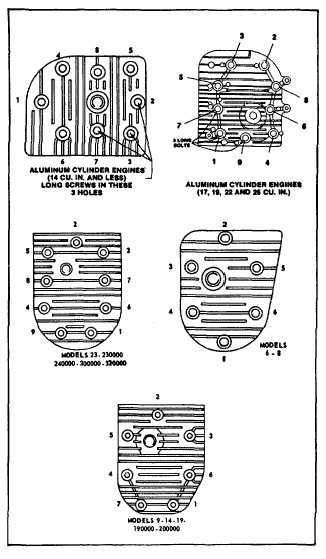COMPRESSION
Cylinder Head
Section 6
COMPRESSION
COMPRESSION
Briggs & Stratton does not publish any compression
pressures, as it is extremely difficult to obtain an
accurate reading without special equipment.
It has been determined through extensive testing, a
simple and accurate indication of compression can be
made as follows:
Spin the flywheel counterclockwise (flywheel side)
against the compression stroke, a sharp rebound
indicates satisfactory compression. Slight or no rebound
indicates poor compression.
Loss of compression will usually be the result of the
following:
1.
The cylinder head gasket blown or leaking.
2.
Valves sticking or not seating properly.
3.
Piston rings not sealing, which would also cause the
engine to consume an excessive amount of oil.
Carbon deposits in the combustion chamber should be
removed every 100 to 300 hours of use (more often
when run at a steady load), or whenever the cylinder
head is removed.
Remove Cylinder Head and Shield
Always note the position of the different cylinder head
screws so that they may be properly reassembled. If a
screw is used in the wrong position, it may be too short
and not engage enough threads. It may be too long and
bottom on a fin, either breaking the fin, or leaving the
cylinder head loose.
CYLINDER HEAD TORQUE PROCEDURE
Assemble the cylinder head with a new head gasket,
cylinder head shield, screws and washers in their proper
places. (A graphite grease or part no. 93963 should be
used on aluminum cylinder screws.)
Do not use a sealer of any kind on gasket. Tighten the
screws down evenly by hand. Use a torque wrench and
tighten head bolts in the sequence shown, Fig. 1, and to
the specified torque in Table 1.
Do not turn one screw down completely before the
others, as it may cause a warped cylinder head.
Fig. 1. Cylinder Heads
JUNE 1981
1

